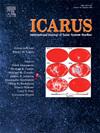紫外线照射下耐辐射球菌类胡萝卜素在矿物基质上的保存与检测
IF 3
2区 物理与天体物理
Q2 ASTRONOMY & ASTROPHYSICS
引用次数: 0
摘要
生物特征(或生物标记),如类胡萝卜素,来源于微生物,是行星表面地质记录中过去或现在生命的有价值的指标。本研究利用拉曼光谱和UV-Vis漫反射光谱研究了多嗜极细菌耐辐射球菌(Deinococcus radiodurans)在各种矿物基质上对类胡萝卜素的抗性和保存。在巴西同步加速器光实验室的环形光栅单色器光束线上,将颜料-基质混合物暴露在模拟火星表面、富含紫外线的陆地环境和空间条件的模拟条件下。我们的研究结果表明,在所有三种模拟环境中,底物的最顶层起着屏蔽辐射的作用,保留了位于表面以下几百微米的生物分子。这种综合方法为在不同行星表面进行分子化石的原位搜索提供了一种有前途的分析方案,消除了大量样品制备的需要。本文章由计算机程序翻译,如有差异,请以英文原文为准。
Preservation and detection of carotenoid pigments of Deinococcus radiodurans on mineral substrates under UV irradiation
Biosignatures (or biomarkers), such as carotenoids, derived from microorganisms serve as valuable indicators of past or present life within the geological record on planetary surfaces. This study investigates the resistance and preservation of carotenoid pigments from the poly-extremophilic bacterium Deinococcus radiodurans across various mineral substrates using Raman spectroscopy and diffuse reflectance in the UV–Vis range. Pigment-substrate mixtures were exposed to simulated conditions mimicking the surface of Mars, a UV-rich terrestrial environment, and space conditions at the Toroidal Grating Monochromator beamline of the Brazilian Synchrotron Light Laboratory. Our findings reveal that the topmost layers of the substrate act as protective shields against radiation, preserving biomolecules located a few hundred micrometers below the surface in all three simulated environments. This integrated approach offers a promising analysis protocol for an in situ search for molecular fossils on diverse planetary surfaces, eliminating the need for extensive sample preparation.
求助全文
通过发布文献求助,成功后即可免费获取论文全文。
去求助
来源期刊

Icarus
地学天文-天文与天体物理
CiteScore
6.30
自引率
18.80%
发文量
356
审稿时长
2-4 weeks
期刊介绍:
Icarus is devoted to the publication of original contributions in the field of Solar System studies. Manuscripts reporting the results of new research - observational, experimental, or theoretical - concerning the astronomy, geology, meteorology, physics, chemistry, biology, and other scientific aspects of our Solar System or extrasolar systems are welcome. The journal generally does not publish papers devoted exclusively to the Sun, the Earth, celestial mechanics, meteoritics, or astrophysics. Icarus does not publish papers that provide "improved" versions of Bode''s law, or other numerical relations, without a sound physical basis. Icarus does not publish meeting announcements or general notices. Reviews, historical papers, and manuscripts describing spacecraft instrumentation may be considered, but only with prior approval of the editor. An entire issue of the journal is occasionally devoted to a single subject, usually arising from a conference on the same topic. The language of publication is English. American or British usage is accepted, but not a mixture of these.
 求助内容:
求助内容: 应助结果提醒方式:
应助结果提醒方式:


